Step into a world of exquisite flavor and delicate texture with this ultimate guide to crafting homemade Danish Butter Cookies. Imagine sinking your teeth into a cookie that’s buttery, delightfully crumbly, perfectly sweet, and melts in your mouth – that’s the magic of these festive treats. This cherished recipe elevates the classic by offering an optional dip in rich chocolate and a vibrant sprinkle of festive decorations, making them the quintessential holiday cookie. Made with a handful of simple, readily available ingredients, these cookies are not just a dessert; they are a tradition waiting to be made and shared.

For many, the mere mention of Danish Butter Cookies evokes a wave of nostalgia, conjuring images of the iconic blue tin that graced kitchen counters every winter. These delightful confections were a childhood staple, a harbinger of festive seasons and cozy gatherings. This homemade Danish Butter Cookies recipe doesn’t just replicate that beloved taste; it enhances it, bringing fresh, warm, and utterly irresistible cookies straight from your oven to your table, perfect for spreading cheer during the holiday season or any special occasion.
Craving more delightful cookie creations? Explore other fantastic recipes like our luscious Raspberry Jam Thumbprint Cookies, zesty Cranberry Orange Shortbread Cookies, charming Gingerbread Christmas Tree Cookies, and comforting Apple Pie Cinnamon Oatmeal Cookies.
The Enduring Charm of Danish Butter Cookies
Danish Butter Cookies are a universally adored delicacy, often recognized by their charming presentation in distinctive blue tins – hence their popular moniker, “Blue Tin Cookies.” While some refer to them simply as Butter Cookies or even Royal Butter Cookies, they all point to the same exquisitely rich, buttery, and incredibly tender biscuits that have captivated taste buds worldwide. Originating from the picturesque villages of Denmark, these cookies are a testament to the power of simple, high-quality ingredients, with butter playing the starring role in creating their signature melt-in-your-mouth texture. In North America, they have become a cherished tradition, particularly during Christmas, symbolizing warmth, generosity, and festive indulgence.
Why These Homemade Danish Butter Cookies Are Unforgettable
- Unrivaled Buttery Perfection: The heart of these cookies lies in their generous butter content, ensuring every bite is rich, deeply flavorful, and unbelievably tender. They don’t just taste good; they literally dissolve on your tongue, leaving a satisfying, crumbly finish that’s truly addictive.
- A Decadent Chocolate Upgrade: While Danish Butter Cookies are superb in their pure form, a simple dip in melted chocolate takes them to an entirely new level of gourmet delight. Whether you choose creamy white, classic milk, or intense dark chocolate, this addition transforms them into an even more luxurious treat. Add a sprinkle of festive decorations, and you have a showstopper!
- Effortless Holiday Baking: Don’t let their elegant appearance fool you. This recipe is surprisingly straightforward, calling for just six staple ingredients and requiring minimal hands-on time. From pantry to plate, these scrumptious cookies can be ready in approximately 35 minutes, making them an ideal choice for busy holiday bakers or anyone seeking a quick yet impressive dessert.
- Nostalgic Comfort in Every Bite: Recreate cherished memories or start new traditions with these cookies. The aroma of freshly baked Danish Butter Cookies fills your home with a comforting, festive scent that brings joy and evokes a sense of holiday magic.

The Essential Ingredients for Superior Danish Butter Cookies
The beauty of Danish Butter Cookies lies in their simplicity. With just a few high-quality ingredients, you can achieve remarkable flavor and texture. Here’s a closer look at what you’ll need and why each component is crucial:
- Unsalted Butter: This is the star of the show. Always use unsalted butter to control the overall saltiness of your cookies. Ensuring it’s at room temperature is absolutely critical. Softened butter creams beautifully with sugar, incorporating air that contributes to the cookies’ light, tender, and airy structure. Cold butter will result in a dense dough, while melted butter can make the cookies greasy.
- Confectioner’s Sugar (Powdered Sugar): Unlike granulated sugar, confectioner’s sugar dissolves effortlessly into the butter, creating an incredibly smooth, melt-in-your-mouth texture. Sifting it well before use is important to prevent any lumps from forming in your delicate dough, ensuring a uniform consistency.
- Pure Vanilla Extract: A touch of high-quality vanilla extract enhances all the other flavors, adding a warm, aromatic depth that is indispensable in any classic cookie recipe. For an extra layer of complexity, consider adding a few drops of almond extract, which pairs wonderfully with butter and can elevate the cookie’s aroma.
- Milk: A small amount of whole fat milk is used to slightly thin the dough to the perfect piping consistency. Whole milk is preferred for its richness, which subtly contributes to the cookie’s overall tenderness without adding excessive moisture.
- All-Purpose Flour: The structural backbone of the cookie. Sift your all-purpose flour meticulously before incorporating it into the wet ingredients. This step aerates the flour, prevents lumps, and ensures a light, even dough that holds its shape beautifully during baking. Accurate measurement is key here; too much flour can lead to dry, tough cookies.
- Salt: A pinch of salt is vital for balancing the sweetness and enhancing all the other flavors. It prevents the cookies from tasting overly sweet and brings out the rich, creamy notes of the butter.
- Chocolate and Sprinkles (Optional but Recommended): For a truly festive and decadent finish, a dip in melted chocolate and a dusting of sprinkles are highly recommended. You can use white, milk, or dark chocolate, depending on your preference. Customize your sprinkles to suit the occasion – holiday-themed sprinkles for Christmas, pastels for spring, or classic rainbow for year-round joy!

Crafting Your Own Homemade Butter Cookies: A Detailed Guide
Making these elegant Danish Butter Cookies at home is a rewarding experience. Follow these steps for a perfectly buttery and tender result:
- Prepare Your Dry Ingredients: In a medium-sized bowl, whisk together the sifted all-purpose flour and salt. This ensures the salt is evenly distributed throughout the flour, preventing pockets of saltiness and contributing to a balanced flavor in every cookie. Set this mixture aside.
- Cream Butter and Sugar: In the bowl of an electric stand mixer fitted with the paddle attachment, combine the softened, room-temperature unsalted butter, sifted confectioner’s sugar, and pure vanilla extract. Beat on medium-high speed for about 3-5 minutes. The mixture should transform into a light, pale, and fluffy consistency. This creaming process is essential for incorporating air, which makes the cookies tender and aids in their beautiful spread.
- Incorporate Milk: Reduce the mixer speed to low and gradually add the milk. Mix just until it is fully incorporated into the butter mixture. Be careful not to overmix at this stage.
- Gradually Add Flour Mixture: With the mixer still on low speed, slowly add the flour and salt mixture to the wet ingredients in 2-3 parts. Mix thoroughly after each addition until just combined. Stop mixing as soon as the flour streaks disappear. The dough will be thick and may clump together, which is exactly what you want for piping. Overmixing the flour can develop gluten, leading to tough cookies.
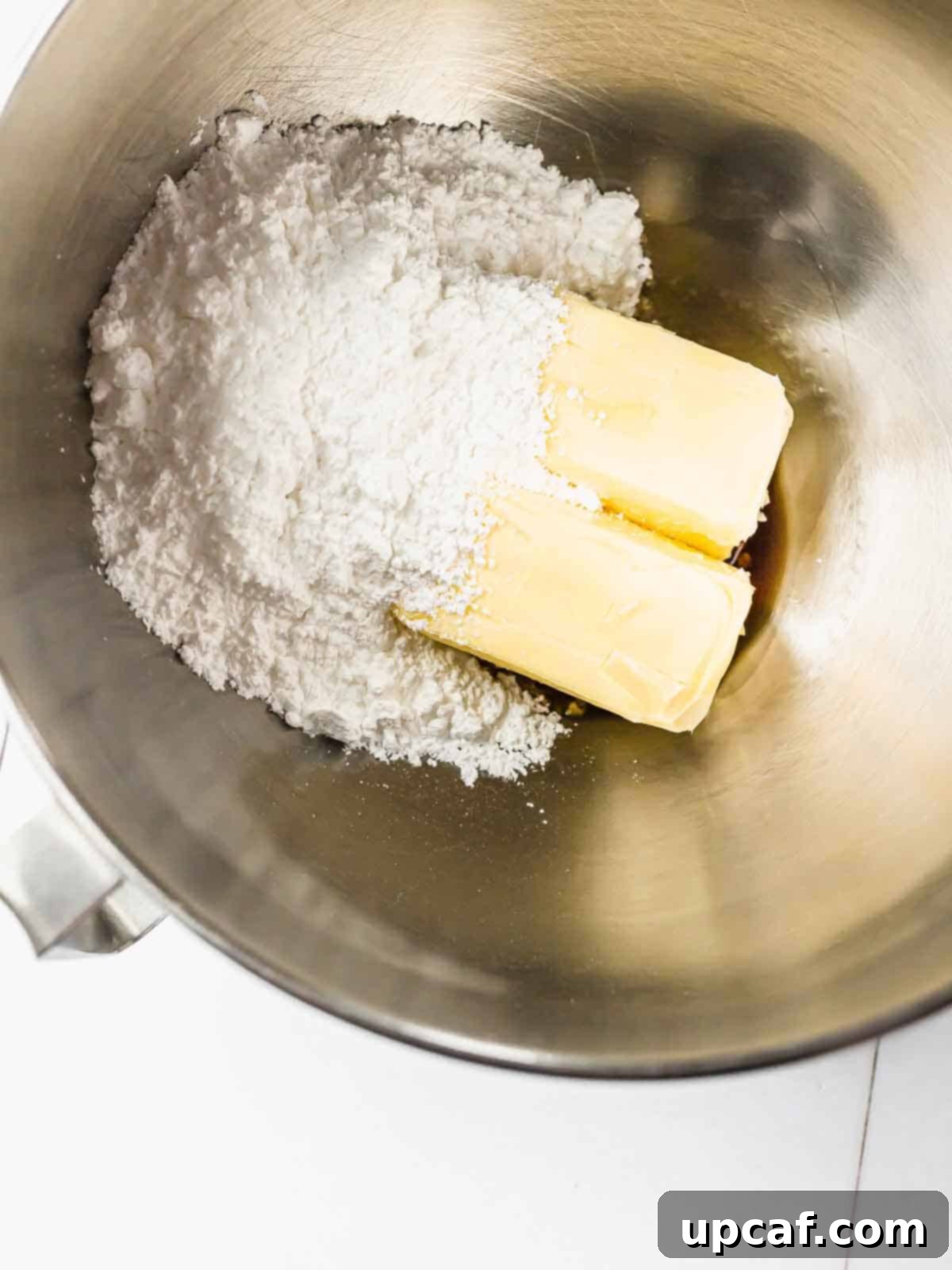
- Prepare for Piping: Transfer the cookie dough into a sturdy pastry bag fitted with a Wilton 1M star tip. This tip is ideal for creating the classic rosette and swirl shapes characteristic of Danish Butter Cookies. If you find the dough a bit stiff, work it gently with your hands inside the bag to warm it slightly, making it easier to pipe.
- Pipe the Cookies: Line a baking sheet with parchment paper for easy release and cleanup. Pipe your desired shapes (rosettes, S-shapes, or classic rings) onto the prepared baking sheet, leaving about 1-2 inches between each cookie to allow for slight spreading.
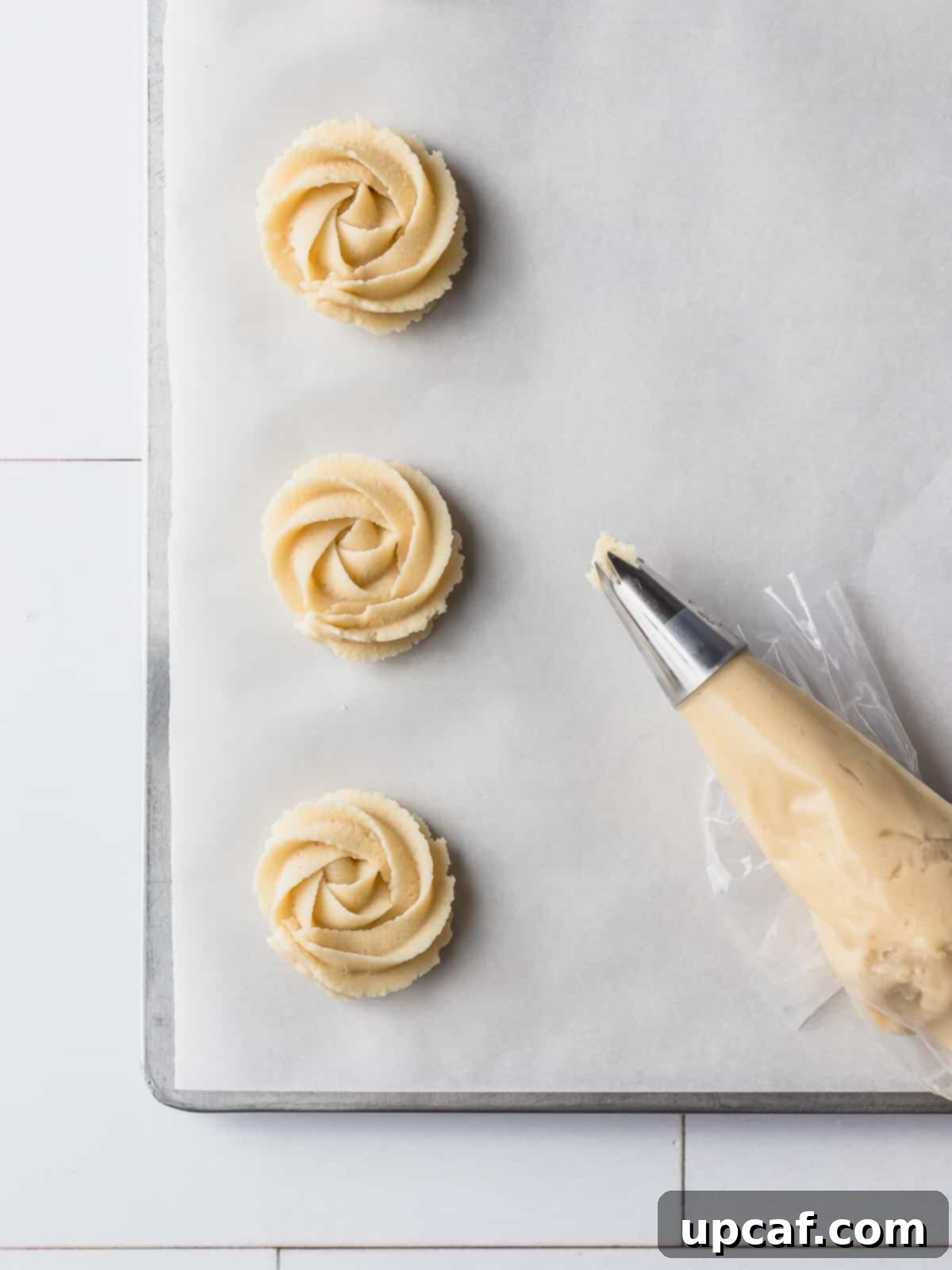
- Chill the Dough (Highly Recommended): For the crispest edges and to ensure your cookies maintain their beautiful piped shapes without spreading too much, refrigerate the piped dough on the baking sheet for at least 30 minutes. This chilling period allows the butter to firm up, resulting in a more defined cookie.
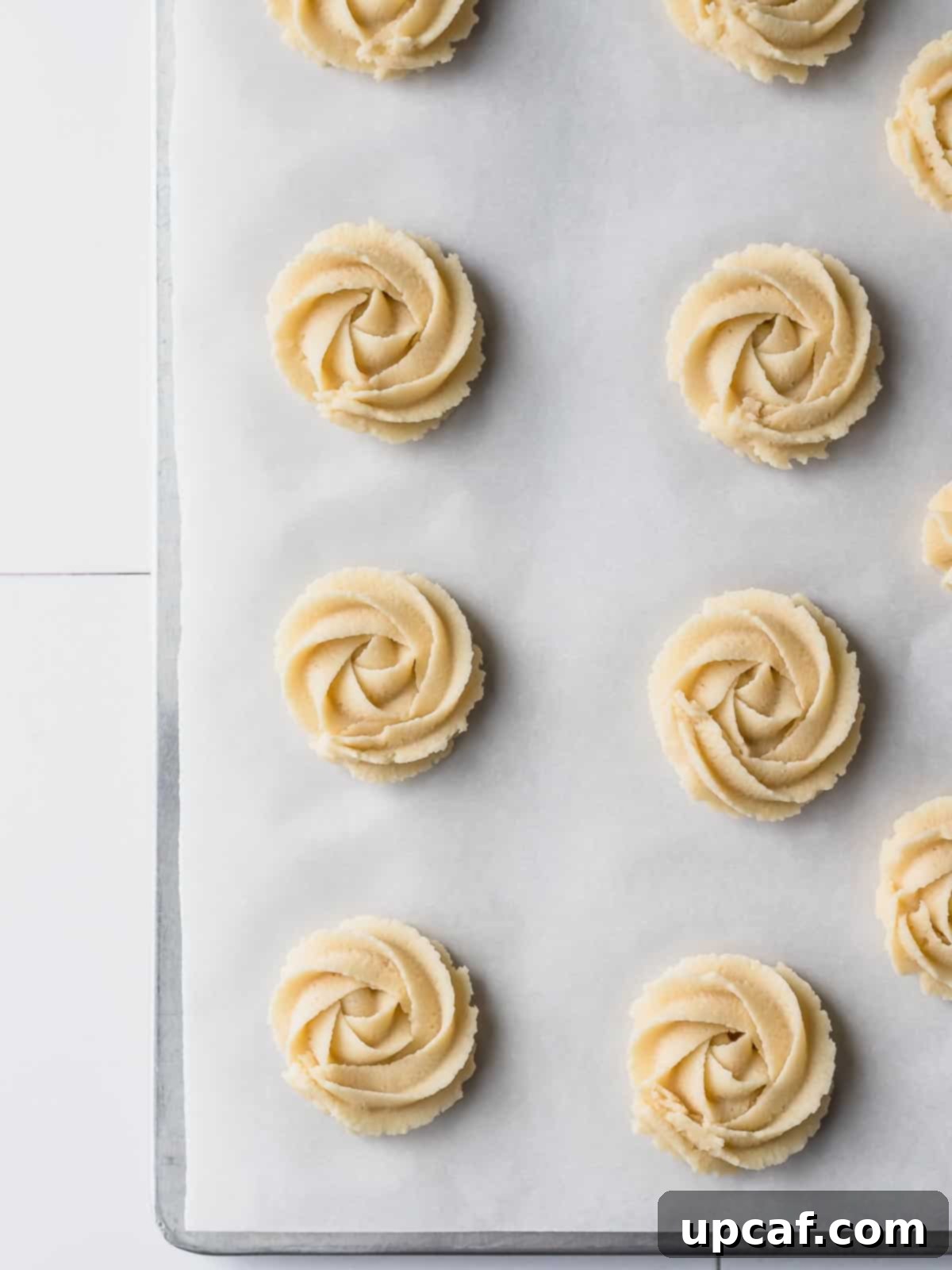
- Bake to Golden Perfection: Preheat your oven to 350°F (175°C). Bake the cookies for 13-15 minutes, or until the edges begin to turn a light golden brown. The centers should still be pale. Keep a close eye on them, as baking times can vary by oven.
- Cool Completely: Once baked, remove the cookies from the oven and let them cool on the baking sheet for a few minutes before transferring them to a wire rack to cool completely. This prevents them from breaking and ensures they set properly.
- Dip (Optional): If desired, once the cookies are completely cooled, you can proceed with dipping them in melted chocolate and adding sprinkles.
- Serve and Enjoy: Once cooled (and decorated, if desired), these delightful cookies are ready to be savored!
Expert Tips for the Best Homemade Danish Butter Cookies
- Always Preheat Your Oven: A properly preheated oven ensures even baking from the moment the cookies enter, preventing them from spreading too quickly.
- Don’t Skip the Chill: As mentioned, refrigerating the piped dough for 30 minutes or more before baking is a game-changer. This simple step firms up the butter, significantly reducing spread and helping your cookies retain their intricate piped shapes beautifully.
- Room Temperature Ingredients are Key: Ensure your butter, and any other dairy ingredients like milk, are at true room temperature. This allows for proper emulsification and air incorporation when creaming, leading to a smooth dough and tender cookies.
- The Art of Piping: For that iconic swirled look, piping is essential. A Wilton 1M star tip is perfect for creating elegant rosettes and other classic shapes.
- Test Your Dough: When you first start piping, try a small amount of dough to ensure it’s creamy enough to pipe smoothly. If it’s too stiff, let it warm up slightly more. If it’s too soft, chill it briefly.
- Parchment Paper is Your Friend: Always line your baking sheets with parchment paper. This prevents sticking, ensures easy removal of your delicate cookies, and makes cleanup a breeze.
- Watch for Subtle Browning: Danish Butter Cookies are done when their edges or “peaks” just begin to turn a light golden brown. The centers should remain pale. Overbaking can make them dry and less tender.
- Chocolate Choices: Experiment with different types of chocolate for dipping – white, milk, or dark chocolate all offer unique flavor profiles that complement the buttery cookie.
- Cool Before Handling or Dipping: Allow the cookies to cool completely on a wire rack before handling extensively or dipping in chocolate. They are quite delicate when warm.
- Do Not Overmix Flour: Once flour is added, mix only until just combined. Overmixing develops gluten, which can make your cookies tough instead of tender and crumbly.

The Art of Dipping Butter Cookies in Chocolate
While Danish Butter Cookies are wonderfully delicious on their own, dipping them in chocolate adds an extra layer of festivity and indulgence, transforming them into an even more irresistible treat. Here’s how to achieve that perfect chocolate coating:
- Melt the Chocolate: Break your preferred chocolate (white, milk, or dark) into small, even pieces and place it in a microwave-safe bowl. Heat in 30-second increments, stirring thoroughly after each interval. Continue until the chocolate is smooth and fully melted. Alternatively, you can use a double boiler for a more controlled melting process, placing a heat-proof bowl over a pot of simmering water, ensuring the bottom of the bowl doesn’t touch the water.
- Adjust Consistency (if needed): If your melted chocolate appears too thick or difficult to dip, add a very small amount (half a teaspoon at a time) of neutral vegetable oil (like canola or coconut oil) and stir until you reach the desired flowing consistency. This helps create a smooth, thin coating.
- Dip and Decorate: Take a completely cooled cookie and carefully dip one side into the melted chocolate. Allow any excess chocolate to drip off. Immediately after dipping, sprinkle with your chosen holiday sprinkles, chopped nuts, or coarse sea salt while the chocolate is still wet. This ensures the decorations adhere properly.
- Set the Chocolate: Gently place the chocolate-dipped cookies onto a baking sheet lined with parchment paper. Transfer the baking sheet to the refrigerator for 10-15 minutes, or until the chocolate has fully set and hardened.
- Bring to Room Temperature: Once the chocolate has set, remove the cookies from the fridge and allow them to come back to room temperature before serving. This enhances their flavor and texture.
Frequently Asked Questions About Danish Butter Cookies
How should I store butter cookies to maintain their freshness?
Proper storage is key to enjoying your Danish Butter Cookies for an extended period. Once completely cooled, store the cookies in an airtight container at room temperature. They will remain fresh and delicious for up to 1 week. If you’ve dipped them in chocolate, ensure the chocolate is fully set before stacking them with parchment paper in between layers to prevent sticking. For longer storage, they can be frozen for up to 3 months.
Are Danish butter cookies the same as shortbread cookies? What’s the difference?
While Danish Butter Cookies and shortbread cookies share a similar buttery base, there are distinct differences, primarily in their ingredient ratios and resulting texture. Danish Butter Cookies typically contain a higher proportion of sugar compared to shortbread, which contributes to a slightly sweeter flavor and a more tender, crumbly, and melt-in-your-mouth texture. Shortbread dough is generally firmer, allowing it to be rolled out and cut into various shapes. Danish Butter Cookie dough, on the other hand, is usually softer and designed to be piped, giving them their characteristic intricate shapes and lighter, airy crumb.
Can I prepare Danish Butter Cookies in advance?
Absolutely! Danish Butter Cookies are an excellent make-ahead treat, which is especially helpful during busy holiday seasons. You can prepare the piped or shaped dough and freeze it unbaked for up to 1 month. To do this, pipe your shapes onto a parchment-lined baking sheet, then freeze them until solid. Once frozen, transfer the solid dough shapes to an airtight container or freezer bag for long-term storage. When you’re ready to bake, arrange the frozen dough on a parchment-lined baking sheet, leaving space between each cookie, and allow them to thaw slightly at room temperature before baking as directed. This ensures they bake evenly and maintain their shape.
Can you freeze baked Danish Cookies?
Yes, you can easily freeze baked Danish Butter Cookies. Once the cookies are completely cooled (and any chocolate dipping has fully set), arrange them in a single layer on a baking sheet and freeze until solid. Then, transfer the frozen cookies to an airtight container or freezer-safe bag, separating layers with parchment paper to prevent sticking. They can be stored in the freezer for up to 3 months. When you’re ready to enjoy them, simply thaw them at room temperature. Freezing baked cookies is a great way to ensure you always have a delightful treat on hand.
Exciting Variations for Your Homemade Danish Cookies
One of the joys of baking Danish Butter Cookies is their versatility. While classic butter cookies are always a hit, feel free to get creative with these delicious variations:
- Diverse Chocolate Dips: Beyond classic milk or dark chocolate, try dipping your cookies in white chocolate for a sweeter profile, or even a swirl of both. For an extra festive touch, after dipping, roll the chocolate side into colorful sprinkles, edible glitter, or finely chopped nuts.
- Fruity Accents: For a pop of color and a touch of fruity sweetness, place a small dollop of raspberry jam, apricot preserves, or a vibrant maraschino cherry right in the center of your piped cookies before baking.
- Savory-Sweet Twist: After dipping in chocolate, sprinkle on some coarse sea salt. The combination of sweet chocolate, rich butter cookie, and flaky salt creates an irresistible gourmet treat.
- Coconut or Nutty Crunch: If you’re a fan of texture, try sprinkling coconut flakes, finely crushed pistachios, almonds, or pecans onto the wet chocolate coating for an added layer of flavor and crunch.
- Citrus Zest: Incorporate the zest of an orange or lemon into your cookie dough along with the vanilla extract for a bright, refreshing flavor that cuts through the richness of the butter.
- Spiced Delights: For a warmer, more aromatic cookie, add a pinch of ground cardamom, cinnamon, or even a hint of nutmeg to your flour mixture. These spices are wonderfully complementary to the buttery base.
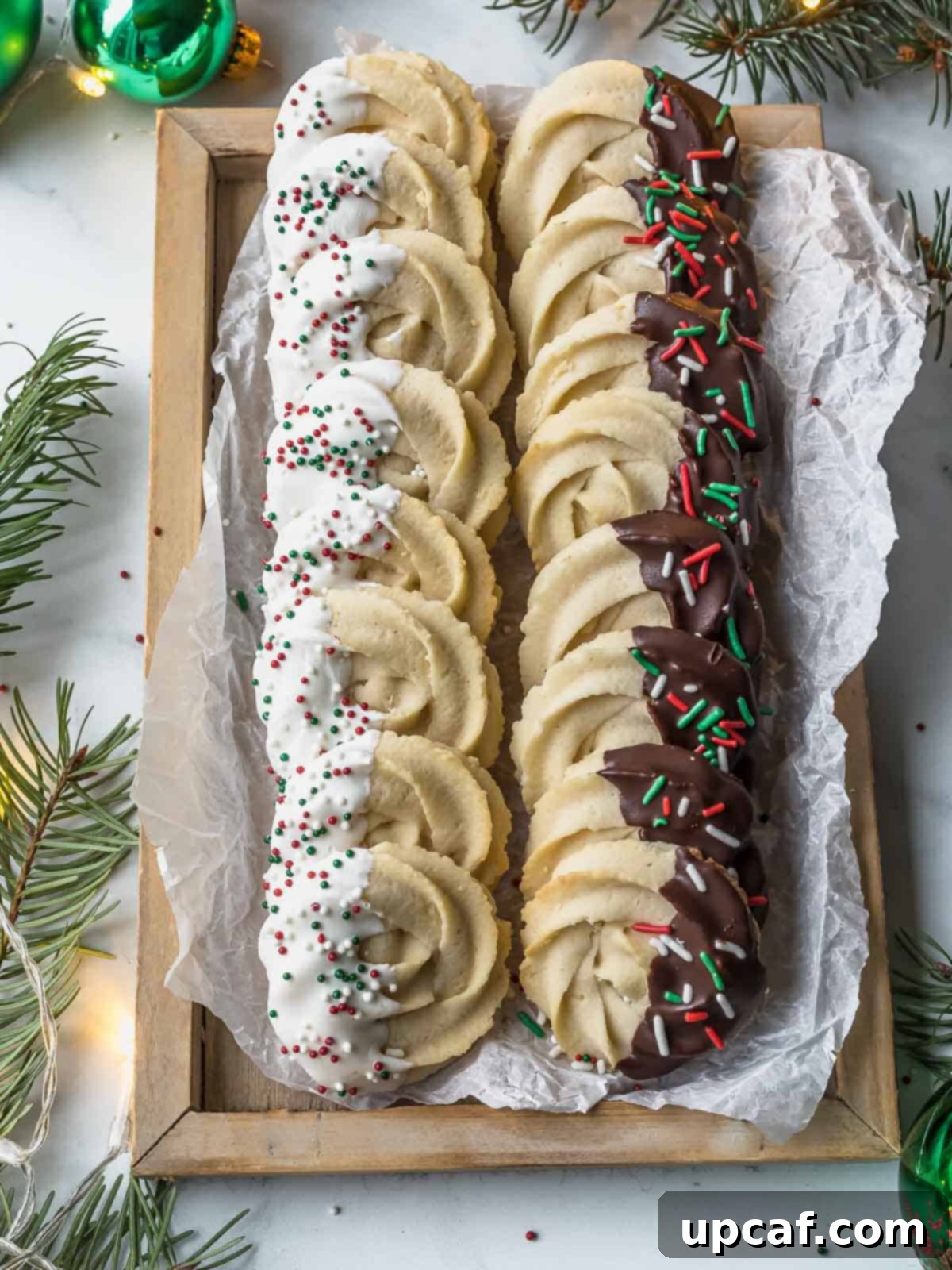
Other Delightful Holiday Desserts to Try
If you’re expanding your holiday baking repertoire, consider these equally enticing dessert options:
- Zesty Orange Holiday Fruit Cake
- Easy Pain Aux Raisins (Custard & Raisin Swirls)
- Irresistible Magic Bars with Coconut
- Simple and Satisfying Easy Pumpkin Bread
I sincerely hope you enjoy creating and savoring this Traditional Danish Butter Cookies recipe, along with all the other delightful culinary adventures I share with you. May your baking bring joy, delicious flavors, and cherished moments!
If you try this recipe and love it, please consider sharing your creation on INSTAGRAM using my hashtag for a chance to be featured! Also, follow Cookin’ With Mima on FACEBOOK | INSTAGRAM | PINTEREST for all the latest updates, inspiring posts, and delicious recipes.
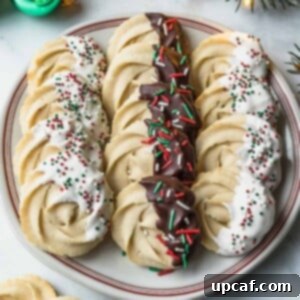
Traditional Danish Butter Cookies
Mariam Ezzeddine
Buttery, crumbly, perfectly sweet, and melt-in-the-mouth – this Danish Butter Cookies recipe has it all! Easy to make and utterly delicious for any occasion.
20 minutes
15 minutes
35 minutes
30 cookies
Ingredients
- 1 cup unsalted butter, soft, room temperature
- 1 cup confectioner sugar
- 2 tsp. pure vanilla extract
- 2 tbsps. milk
- 2 cups all-purpose flour
- ½ tsp. salt
Instructions
- Preheat oven to 350°F (175°C).
- In a medium bowl, whisk together salt and all-purpose flour. Set aside.
- In a bowl of an electric stand mixer, place butter, confectioners’ sugar, and vanilla. Using the paddle attachment, beat on medium-high for about 3-5 minutes until light and fluffy.
- Add milk. Mix to incorporate.
- Gradually add the flour mixture in 2-3 parts, mixing thoroughly with every addition until just combined. The dough will clump together.
- Transfer the dough into a sturdy pastry bag with a Wilton 1M attachment.
- Pipe rosettes or your desired shapes onto a cookie baking sheet lined with parchment paper.
- For best results, refrigerate the piped dough for 30 minutes before baking to prevent spreading.
- Bake for about 13-15 minutes or until lightly golden on the sides and edges.
- Let cool completely on a wire rack.
Dipping Process (Optional)
- To dip the cookies in chocolate, melt your desired chocolate in a microwave oven by 30-second increments, stirring after each time. If the melted chocolate seems too thick, add a small amount of vegetable oil to thin it.
- Dip cooled cookies into the melted chocolate and immediately sprinkle with some holiday sprinkles or other toppings.
- Place chocolate-dipped cookies onto parchment paper and transfer to the refrigerator for 10-15 minutes to allow the chocolate to set.
- Once the chocolate has set, take the cookies out of the fridge and let them come to room temperature before serving for optimal flavor and texture.
- Store cookies in an airtight container for up to a week.
Notes
- Use a preheated oven for even baking.
- Chilling the piped dough for about 30 minutes before baking is highly recommended to prevent spreading and ensure beautiful, well-defined shapes.
- Ensure all ingredients, especially butter, are at room temperature for optimal dough consistency.
- For that amazing swirl look, the dough must be piped using a star tip, such as a Wilton 1M.
- When piping, start with a small amount of dough to check its consistency. It should be creamy enough to pipe smoothly but firm enough to hold its shape.
- Always use a cookie baking sheet lined with parchment paper for easy removal and effortless cleanup.
- Cookies are done when their sides or edges are slightly golden brown, while the centers remain pale.
- Feel free to use white, milk, or dark chocolate for dipping to suit your taste preferences.
- Allow cookies to cool completely before serving, dipping, or storing.
Nutrition (Per Cookie)
Carbohydrates: 10g |
Protein: 1g |
Fat: 6g |
Saturated Fat: 4g |
Cholesterol: 16mg |
Sodium: 33mg |
Potassium: 12mg |
Fiber: 1g |
Sugar: 4g |
Vitamin A: 189IU |
Calcium: 4mg |
Iron: 1mg
Like this recipe? Share it with your friends!
